
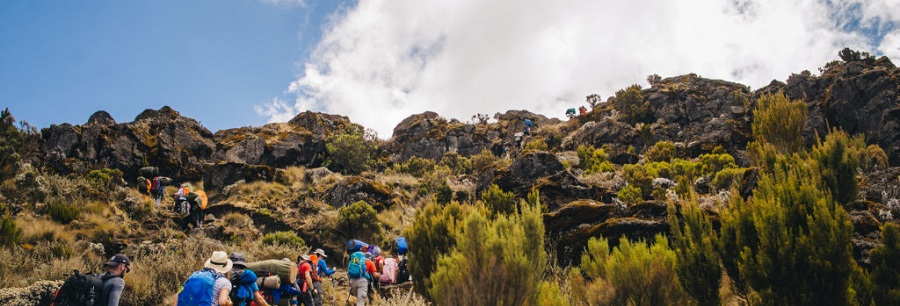
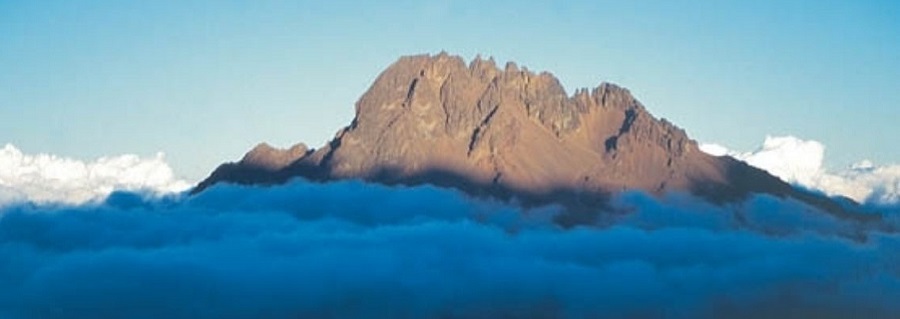

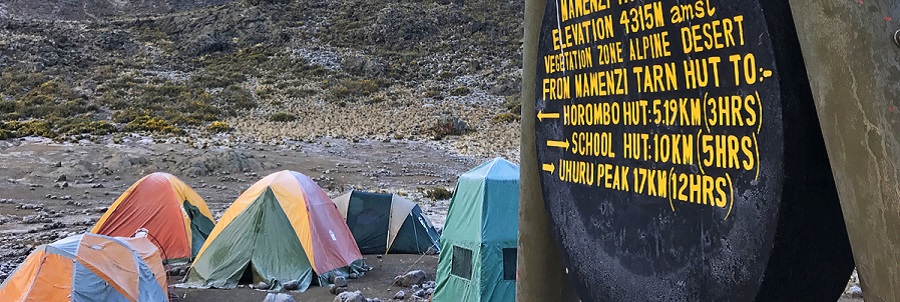

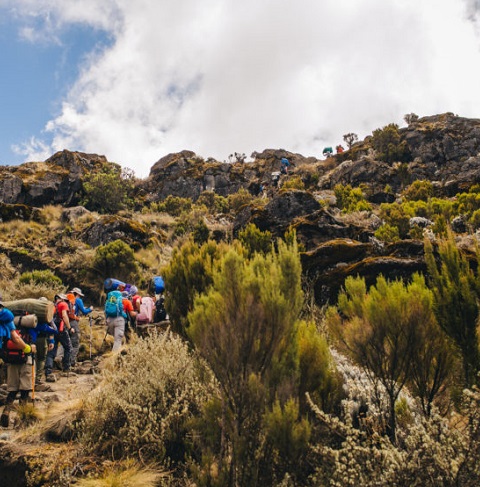
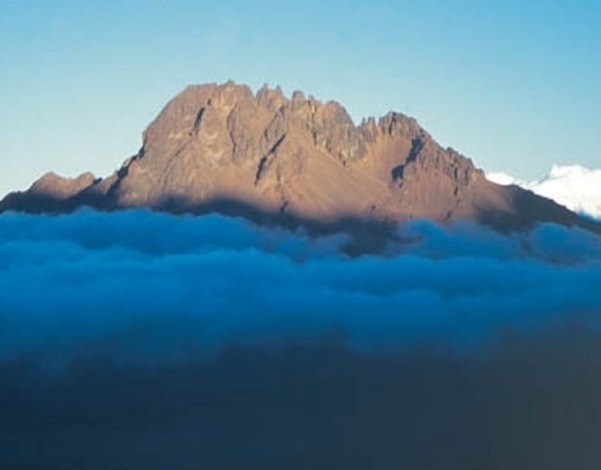
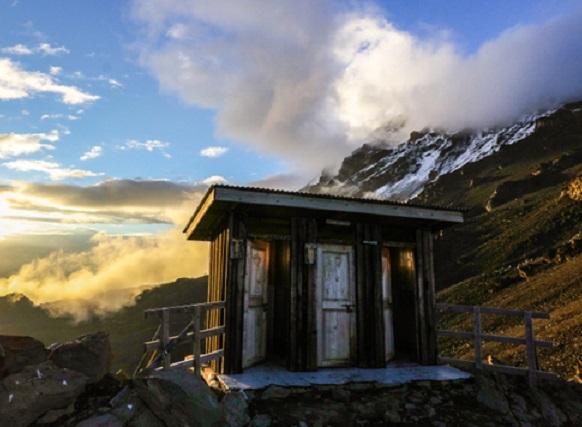
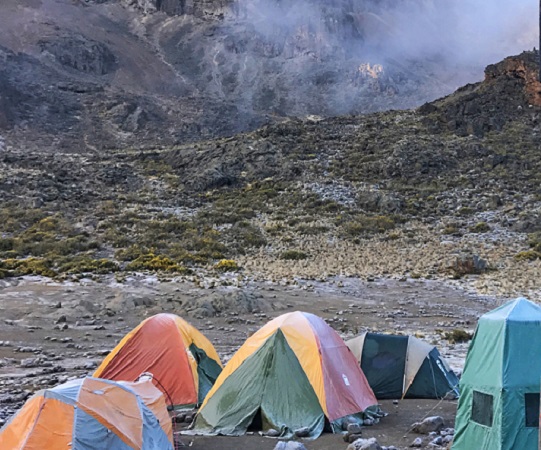
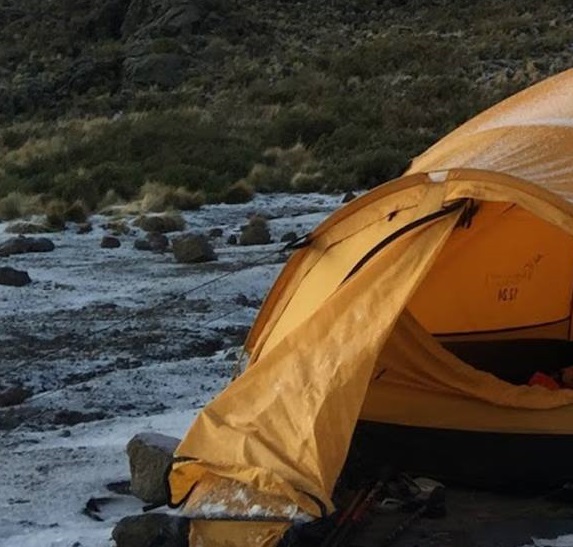
Begeben Sie sich auf dieses aufregende und attraktive 6-tägige Wanderabenteuer auf dem Kilimanjaro Rongai und genießen Sie auf dem Weg zum Gipfel Afrikas faszinierende Ausblicke und unberührte Tierwelt. Eine der beliebtesten Routen mit tollem Akklimatisationsübergang ist die ideale Wahl für Anfänger und erfahrene Wanderer. Sie durchqueren mehrere Klimazonen (vom Regenwald bis zur arktischen Wüste), jede anders, einzigartig, fesselnd und attraktiv. Unsere professionellen Klettercrews sorgen für Ihre Sicherheit und Ihren Komfort. Übernachtet wird in unseren begehbaren Zelten (von uns entworfen und auf den Kilimandscharo zugeschnitten), das Küchenteam überrascht mit seinen Kochkünsten und die Träger tragen das gesamte Equipment. Die Guides werden Ihnen den Weg weisen und aufgeregt ihr Wissen über diesen erstaunlichen Berg teilen
Ein Guide und eine Bergbegleiter-Crew treffen am Morgen im Hotel ein, um Sie zu treffen und eine kurze Einweisung zu geben. Anschließend fahren Sie mit dem Fahrzeug zum Nordeingang des Kilimanjaro-Nationalparks: dem Nalemuru Gate (2.020 m). Nach der schnellen Formalität, Klettergenehmigungen einzuholen und sich beim Such- und Rettungsdienst anzumelden, wird die Gruppe zum Simba Camp (2.625 m) trekken. Ihre Wanderung an diesem Tag wird moderat sein und Sie durch einen wunderschönen Nadelwald den Nordhang des Kilimanjaro hinaufführen. Denken Sie daran, sich nicht zu beeilen und halten Sie immer ein angenehmes Tempo. Wenn Sie das Camp erreichen, bereitet unsere professionelle Bergcrew alles Notwendige vor, baut Zelte auf und kocht das Abendessen für Sie. Dies ist Ihr erster Tag in dieser Höhe, daher wird dringend empfohlen, ab diesem Zeitpunkt die folgenden Anweisungen zu beachten: - Verzichten Sie auf Alkohol und Koffein - Trinken Sie täglich mehr als 4 Liter Mineralwasser (nach und nach) - Nehmen Sie eine Diamox-Pille zur Linderung der Symptome der Höhenkrankheit. Die meisten Bergsteiger nehmen Diamox morgens vor dem Aufstieg ein, um die mit der Höhenkrankheit verbundenen Beschwerden zu reduzieren. Wir empfehlen Ihnen, bei möglichen Allergien vor Reiseantritt Ihren Arzt zu konsultieren. Nachts kann es zu Beschwerden bei der Akklimatisierung an die große Höhe kommen: Durch die Verringerung Ihres Atemmusters im Wachzustand bekommt Ihr Körper weniger Sauerstoff als tagsüber. Unter Berücksichtigung der Höhe kann es daher zu Übelkeit und Kopfschmerzen kommen. Achten Sie auf Ihren eigenen Körper und informieren Sie Ihren Guide, wenn Sie Symptome der Höhenkrankheit verspüren.
Frühmorgens nach dem Frühstück bricht die Gruppe vom Simba Camp auf, um zu Ihrem zweiten Höhencamp zu wandern: Kikilewa Camp (3.630 m), wo Sie den herrlichen Kibo-Vulkan von seiner schönsten Seite sehen können (außer bei bewölktem Wetter). Dieses Trekking ist körperlich anstrengender als das vorherige, daher wird eine vollständige Erholung empfohlen, sobald Sie im Camp sind.
Tourist(e) und das Team stehen früh auf, frühstücken und beginnen das Trekking zum Mawenzi Tarn Camp, das am Fuße des Mawenzi-Vulkans, dem zweiten Gipfel des Kilimanjaro, liegt. Wenn Sie das Camp erreichen, essen Sie zu Mittag und machen eine zweistündige Pause, danach folgt eine Akklimatisierungswanderung zum Mawenzi-Vulkan mit 200 Höhenmetern, gefolgt von einer Wanderung zurück zum Mawenzi Tarn Camp, wo Sie wird am Abend zu Abend essen. Hinweis: Die Akklimatisierungswanderung ist eine leichte Wanderung mit einem leichten Höhengewinn, um den Akklimatisierungsprozess zu beschleunigen. Die Akklimatisierungswanderungen sollten Sie sehr ernst nehmen. Sie helfen, Ihre Chancen auf eine erfolgreiche Besteigung des Kilimanjaro zu erhöhen und bewahren Sie vor den Folgen der Höhenkrankheit, die Sie vom Gipfel abhalten könnte.
An diesem Tag wandern wir zum School Hut Camp (4.715 m). Die Landschaft wird sich stark verändern und einer felsigen Halbwüste weichen. Das eigentliche Trekking ist nicht sehr schwierig; Denken Sie nur daran, ein angemessenes Tempo einzuhalten, um Ihre Kräfte für das Trekking zum Kilimanjaro-Gipfel zu halten. Wenn Sie das Camp erreichen, empfehlen wir Ihnen, gut zu schlafen, anstrengende Aktivitäten zu vermeiden und so viel wie möglich zu trinken, denn in dieser Nacht werden Sie den Uhuru Peak (5.895 m) besteigen.
Nachtabfahrt vom School Hut Camp (4.715 m) und Beginn Ihres Trekkings zum Kilimanjaro-Gipfel: Uhuru Peak (5.895 m). Das Trekking wird aus körperlicher Sicht moderat sein, aber die Höhe stellt ein viel schwerwiegenderes Problem dar. Während des gesamten Trekkings wird jedes Bergsteigerpaar von einem eigenen Guide begleitet, der Ihre Ausdauer und mentale Entschlossenheit überwacht. Nach Ihrem erfolgreichen Aufstieg zum Uhuru Peak können Sie auf Wunsch zum nächsten Gletscher absteigen. Dann kehren Sie zum Kibo Camp zurück und setzen nach einer zweistündigen Pause Ihren Abstieg zum Horombo Camp (3.720 m) fort. Hinweis: Vergessen Sie nicht, dass 90% aller Unfälle während des Abstiegs passieren, einschließlich aller gebrochenen Arme und Beine. Bitte achten Sie auf Ihre Füße, da ein hohes Risiko besteht, Ihren Zehennagel zu beschädigen
Am Morgen wird Ihnen ein warmes Frühstück angeboten, danach fahren wir zum Ausgang des Kilimanjaro Nationalparks: Marangu Gate (1.860 m). Nach Ihrem Abstieg vom Berg versammelt sich die ganze Gruppe, um Ihnen zu gratulieren, und dann haben Sie die Möglichkeit, Ihre Meinung zur Reise im Gästebuch zu teilen. Abschließend überreichen wir Ihnen Ihre Erinnerungsurkunden (in unserem Büro) und sorgen für einen Rücktransfer zum Hotel
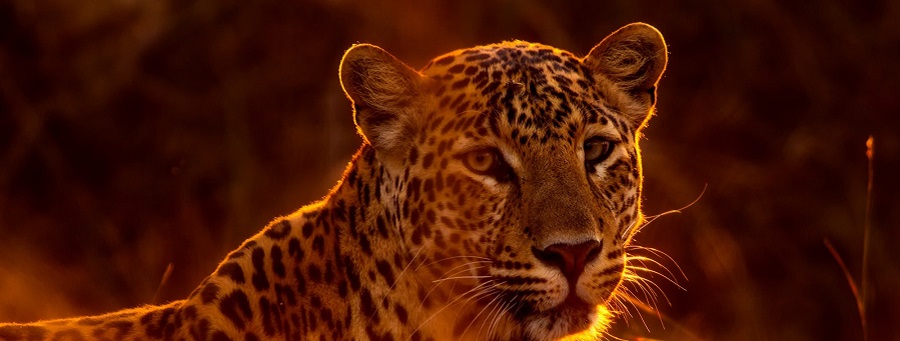
o Parkgebühren
o Hüttengebühren
o Rettungsgebühren
o 18% Mehrwertsteuer auf Tourgebühren und Dienstleistungen, die fast 55% der berechneten Gesamtkosten kosten
o Transport zum und vom Bergtor
o Professionelle Bergführer, Köche und Träger
o 3 Mahlzeiten täglich am Berg
o Gefiltertes Wasser während der gesamten Wanderung
o Faire Löhne für die Bergbesatzung, wie von der Kilimanjaro National Park Authority (KINAPA), der Kilimanjaro Association of Tour Operators (KIATO) genehmigt
o Sowohl nationale als auch internationale Flüge
o Krankenversicherung
o Die Visakosten betragen 50 US-Dollar, außer für Inhaber eines kanadischen und US-amerikanischen Passes 100 US-Dollar
o Tipps für die Bergmannschaft
o Gegenstände persönlicher Natur
o Wäscheservice
o Ein Arzt für die Gruppe
o Alkoholische Getränke
o Eine tragbare Spültoilette mit einem Toilettenzelt ist extra (100 USD pro Toilette + Toilettenzelt)
The Rongai route is the only route that approaches Kilimanjaro from the north, close to the Kenyan border. Though gaining popularity amongst climbers, Rongai has low traffic. It is the preferred route for those looking for an alternative to the crowded Marangu route, for those who would like a more remote hike, and for those who are climbing during the rainy season (the north side receives less precipitation).
The minimum number of days required for this route is six days, and seven days are recommended.
Although the scenery is not as varied as the western routes, Rongai makes up for this by passing through true wilderness areas for days before joining the Marangu route at Kibo camp. This route descends down the Marangu route. Rongai is a moderately difficult route, and is highly recommended, especially for those with less backpacking experience.
The Rongai Route is the only trail that starts from the Northern, or Kenyan side of Mt. Kilimanjaro.
Because of its remote location the route offers trekkers a relatively unspoilt wilderness experience where it is possible to see large wildlife like antelope, elephant and buffalo.
The North-East side of the mountain gets significantly less moisture than the southern slopes which means that trekkers are less likely to encounter rain. Trekkers are also more likely to get clear, unclouded views of the mountain.
The Rongai Route is flatter than the other Kilimanjaro routes but because of its profile it does not offer trekkers good options to climb high and sleep low.
It can be hiked on a six, seven or even eight day route. The seven or eight day Rongai Routes are highly recommended as trekkers have extra days to acclimatise.
Summit night from Kibo Hut is steep and follows the same path taken by Marangu trekkers which passes Gilman’s Point to Uhuru Peak.
Due to its remote setting the Rongai Route receives the least traffic of all the routes on Kilimanjaro.
The Rongai Route descends via the Marangu trail.
The Rongai route is the only route that approaches Kilimanjaro from the north, close to the Kenyan border. Though gaining popularity amongst climbers, this route still experiences low crowds. Rongai has a more gradual slope than the mountain’s other routes. It is the preferred route for those looking for an alternative to the popular
Marangu route, for those who would like a more remote hike, and for those who are climbing during the rainy season (the north side receives less precipitation). Rongai is a moderately difficult route, and is highly recommended, especially for those with less backpacking experience.
Although the scenery is not as varied as the western routes, Rongai makes up for this by passing through true wilderness areas for nearly the entire way. Descent is made via the Marangu route
To climb Mount Kilimanjaro on the Rongai route used to guarantee you a quiet trek away from the masses.
The Rongai route is marketed as a remote wilderness experience and for much of the year it still is.
But watch out: over the last years Rongai has seen a surge in popularity.
If you climb Kilimanjaro on the Rongai route during the main season (August to mid October) and if your climb starts on the usual group departure day, you may find yourself in the middle of a pretty big crowd.
(Most groups depart Sunday, so people can finish work Friday, arrive Saturday, start climbing on Sunday and be back in the office the Monday after.)
Still, Rongai remains much quieter than the popular Machame orMarangu trails. It also has several other advantages that should make it one of your first choices:
A drawback is that to get to the other side of Kilimanjaro you have to drive for a couple of hours, and that costs extra. So Rongai is more expensive than a six day trail on Machame or Marangu.
The other drawback is that the Rongai route has a reputation as being less scenic than other routes.
However, that applies mostly to day one, when you will be trekking through fairly open country instead of the dense rainforest. But you'll see the rainforest on your descent! You are not missing out on anything.
The Rongai route has several variations. It can be done as a five, six or even seven day trek.
The extra day is not spent in the same camp as the previous day.
(If you take an extra acclimatisation day on the Marangu Route you will simply hang around one camp for a second night.)
The six day Rongai trek usually follows a different trail than the five day version. After day two you make a detour towards Mawenzi Peak. Some operators of six day treks simply ascend slower, making an extra camp instead of the detour. All seven day treks make the detour to Mawenzi.
This itinerary (and the detailed route description below it) describes the six day trek with the detour via Mawenzi Tarn, one of the most scenic campsites on the montain.
(Note: altitudes and distances are approximations. Different sources will give you different numbers.)
Starting Point: Nalemoru (about 1950 m/6400 ft)
Your first day on Kilimanjaro starts with the transfer from your hotel to the village of Nalemoru. Yep, Nalemoru, not Rongai.
This route used to start from the border village of Rongai, hence the name Rongai route, which is still widely used. But the start of the route was eventually moved away from the Kenya border, to Nalemoru near Loitokitok. So now you may find any of these names used in descriptions and even on signs of the trail: Rongai route, Loitokitok route or (rarely) Nalemoru route. Rest assured, it's all the same trail.
The drive from Moshi or Marangu, around Kilimanjaro, to the Rongai route on the other side, takes two to three hours. It is a picturesque drive through the rural Chagga villages in the foothills.
However, due to the rough track it is at the same time a bumpy ride that leaves everything inside your vehicle the same colour, evenly covered with dust. (A major road upgrade appears to be under way, so we'll see what happens.)
Depending on your timing you may have your packed lunch at Nalemoru while you wait for all your gear to be distributed amongst the porters and for everyone to get ready.
The first day on the Rongai route leads intially through cypress plantations, then through fairly open country with only two patches of montane forest. Even those forests are nothing like the rainforest on the western and southern slopes. The scenery of the first day may not be that memorable, but the wildlife can be.
Birdlife is prolific and you should also see some colobus monkeys. What you may spot beyond that depends on the time of the year and the amount of people on the trail, but Rongai is certainly one of the routes that offers a greater chance of seeing wildlife on Kilimanjaro.
The patchy forest quickly gives way to the heather that dominates this day and the next.
You soon reach the First Cave Campsite where your porters should have already set up your tents and may even have hot drinks and popcorn waiting.
By the way, there aren't any big caves to look at. In fact, there is nothing significant about this campsite at all, except for the people.
If you climb during the busy season don't be surprised if you see this camp teeming with climbers and staff. Also, don't be too disheartened. Because the Rongai route has several variations, the groups will soon go different ways.
If you managed to pick a quiet day then this is actually a really nice camp, with lots of wildlife and a real sense of wilderness about it.
Until lunch time all groups still follow the same path, through moorland covered in heather, on an increasingly steep trail, to the lunch spot known as the Second Cave Camp (3450 m/11320 ft).
Some people will have lunch here and continue, some may even make camp.
(Six day treks without the Mawenzi detour may spend a night here, the next night at Third Cave Camp, and then continue to Kibo Huts. I strongly recommend the Mawenzi Tarn detour instead.)
The much nicer six day route, the one that allows for excellent acclimatization, swings south east towards Mawenzi.
The path, not so steep any more, ambles through the heathland with the occasional rocky section and a few little ups and downs to keep things interesting. I find this a very enjoyable day, with great views towards Mawenzi, Kibo with its eastern icefields, and, weather permitting, back down the mountain over the Amboseli Plains into the distance.
It is, however, a long day. Especially those who start to feel the altitude will be glad to arrive at the next campsite, the Kikelewa Caves Camp, near a group of small caves in a valley below the saddle.
Today you wake up to great views of Kibo in the early morning sun. Your day starts as yesterday finished, on an easy path up a gentle slope. But soon the scenery changes and the trail becomes steeper and steeper.
There used to be a huge number of the giant senecios lining this section of the way. Unfortunately a fire that swept up this slope destroyed most of them. Only a few of them are slowly coming back to life now.
But the last of the vegetation will disappear soon.
If the steepness of the path starts to bother you, know that you must be near your next campsite! Today is a short day and you will have lunch at camp.
The Mawenzi Tarn Campsite is one of the most spectacular campsites on the mountain, right underneath the jagged peak of Mawenzi, in a protected hollow, next to a tiny lake.
Several paths lead up the ridges and towers of Mawenzi, taking you to great views across the saddle towards Kibo. You will be doing some exploring on an acclimatization walk in the afternoon. After a hot lunch and some rest, that is.
Today the direction changes sharply as you start heading back towards Kibo, first climbing over a small ridge, and then wandering on a comfortable path along the northern side of "The Saddle".
If the view is clear it will be breathtaking, especially when you get your first peak over that ridge.
The saddle is the barren plain of alpine desert between the two main peaks of Kilimanjaro: Mawenzi and Kibo. The only living things left are some hardy grasses and the occasional everlasting flower. (How DO they do it? Blooming in this environment.)
The landscape can be quite dramatic, open and windswept, with big clouds rolling across it, big boulders to rest amongst... Many people really enjoy this part. But it all depends how well acclimatized you are.
After the acclimatization day yesterday most people feel fine and this is an easy stroll until you get to the end. The last part leading up towards the Kibo Huts is steeper, the air is thin, and you will feel the lack of oxygen.
You will be looking at Kibo the whole time, and you will be having a good view of the challenge that lies ahead for you tonight.
Just take it very easy. The best thing about this route is that it will be only around lunch time when you get to Kibo Huts. You'll have plenty of time to eat, rest and acclimatize some.
Just before you get to the Kibo Huts you will be joining the wide beaten path of the Marangu route, and you will realize just how remote the last days have been.
The Kibo Huts themselves are not exceptionally scenic, but you will likely be camping a little below them, with good views back over the saddle.
Have an early dinner and early night, and hopefully get some sleep. This is the big night...
The Rongai route is the easiest route up Kilimanjaro. It has a reputation as a remote wilderness trail. Rongai is the only route to approach Kilimanjaro from the north.
Duration: 5 or 6 days
Advantages:
Disadvantages:
The Rongai route on Mount Kilimanjaro is a seven day camping route; it has the attraction of being a lower traffic and easier route compared to the southern slopes for climbing Kilimanjaro. It attracts about 10% of visitors to the mountain. The route is really a complete traverse, the only one to experience the arid northern side and the lush southern side. It's also known as the Loitokok Route.
Starting from the Kenyan side of the mountain in the north its advantages are a more gradual and easier route in terms of terrain, plus there are excellent clear views of the mountain all through the approach. There is also more opportunity to see wildlife such as buffalo, elephant and antelope.
The seven days includes a day of acclimatisation at Mawenzi Tarn and this is an important addition because the flatter terrain means you can't 'climb high, sleep low' which is a good approach to acclimatisation. This extra day helps a lot and means the summit success rate on this route is quite high at over 80%. A six day itinerary without the acclimatisation daylowers the summit success rate to about 65% and it's much more likely to get altitude sickness.
The route is quieter and flatter, and arguably has less scenic quality than other routes on the south side. However walking across the open plain with the summit massif in view all the time gives a real sense of vastness to the mountain. It is drier because of the fact that the mountain itself stops the rain clouds coming up from the south, so it's really a very different experience in terms of scenery and terrain. For many, the solitude and sense of space is a big draw, although you don't get to experience all the different habitats which are evident on the south side routes like Machame and Lemosho.
It takes five days to ascend from the NNE through the forest and onto the heathland and to the last camp at Kibo where it joins the Marangu route. Summit day is on day six up to Gilmans Point on the crater rim and then up to Uhuru Peak and all the way down to Horombo Hut, and the seventh day is a descent to Mweka Gate which is just half an hour drive from Moshi.
We use top quality mountain tents, comfortable mattresses, and qualified guides who work with us full time, porters who carry the bags and equipment, and cooks who provide fresh food every day. The ratio of guide:climber is 1:2. You can read about Kilimanjaro preparation and Kilimanjaro safety on our More Info pages and there is also a comprehensive Kilimanjaro packing list.
Because this route lies in the rain shadow of the mountain and is drier, it's possible to climb the Rongai during rainy season as well as all other times of the year. Rainy season is April - May and October - December.
No, this route is less busy and more remote, but arguably less scenic than routes from the south side of the mountain. The Northern Circuit route does meet up with this route at the caves but you will only see other people from Kibo onwards.
The total distance is 72 kilometres with the longest day being summit day at 21 kms. This route has an acclimatisation day at Mawenzi Tarn which helps with acclimatisation but there is less of the 'climb high, sleep low' option so we only do this route in seven days, which is the recommended number of days for a climb of this altitude.
The camps on this route are less frequented and a bit more basic than the other routes but they all have toilet facilities and a Rangers hut. There are no huts, this is a camping route only.
In general the temperatures will be hot and quite humid on the lower slopes, getting increasingly colder as you get higher. Prepare for a variety of conditions, from wearing T-shirts and shorts on the first day or so, to very warm parkas, hats and gloves for summit night. Do read our full packing list for Kilimanjaro and contact us for any questions about brands or particular models
.
The Rongai route is the only route that approaches the summit from the northern side of the mountain, near the Kenyan border. It’s one of the least crowded of the seven Kilimanjaro routes.
It’s recommended to do the seven-day itinerary (as opposed to the six-day itinerary) as the topography of this trail doesn’t afford many opportunities to ‘climb high, sleep low’. The seven-day itinerary includes an acclimatisation day at Mawenzi Tarn Camp, which gives your body time to adjust to the higher elevation. Acclimatisation is important in allowing you to reach the summit.
’s a decent route choice for those looking to climb during the rainy season, as the north side of the mountain generally receives a little less precipitation.
We recommend choosing this route if you want to avoid the crowds. It’s also a good option if you have less or no trekking experience and want a more relaxed climb with fewer steep sections. (You might also like to read our trekking tips for beginners.)
Though there aren’t opportunities to climb high and sleep low on the Rongai, if you opt for the seven-day itinerary (over the six-day one) you have an an acclimatisation day at Mawenzi Tarn Camp. We highly recommend this.
The Rongai route is for climbers who want a more remote climb away from the crowds and are interested in seeing both sides of the mountain.
The Rongai route is often considered one of the less scenic Kilimanjaro routes. However, because the northern side of the mountain is a little less prone to rainfall, you’re more likely to get clear, unclouded views of the mountaintop along the way. Whoop whoop!
No Kilimanjaro climb is easy – it’s important you know that. But relatively speaking, the Rongai route is considered one of the ‘easier’ routes, as it has a gentle incline throughout. It’s a bit of a longer hike for this reason.
What makes the Rongai route ‘hard’ is its less-than-ideal acclimatisation profile, because it doesn’t often have you climb high during the day and then drop back down for the night, which is a key strategy in helping one’s body acclimatise to the increased elevation.
In fact, there’s only one day on the trail when you climb high and then sleep low. You can combat this by opting for the seven-day itinerary over the six-day one to at least give your body another day to adjust to the changes in altitude on your ascent. Put simply, with the right Kilimanjaro preparation anyone can climb it.
Note that you should be physically fit to attempt to climb Kilimanjaro, though you don’t need any previous trekking experience. The Rongai route is not technical at all, meaning a good pair of hiking boots strapped onto some decently strong legs is all you need. That said, if you’re new to multiday hikes, we recommend you read our trekking tips for beginners
Whilst there are no official statistics, the average success rate for the seven-day Rongai route across all Kilimanjaro operators is 80%, and 65% for the six-day route.
If you compare these statistics with those of routes like the Lemosho route and Northern Circuit route, you’ll see they aren’t particularly good. The reason for this low success rate is the route’s poor acclimatisation profile: it only offers one opportunity to climb high andsleep low. Days when you hike up to a new altitude and then descend to a lower altitude for the night are incredibly helpful for acclimatisation.
The Rongai route is the least frequented of the Kilimanjaro routes. It’s the only route to approach the summit from the northern side of the mountain.
Trekkers often don’t consider the Rongai route because of the perception that it’s not as beautiful. However, it’s actually a very beautiful Kilimanjaro route. We think it’s a good choice if you’re looking for a quieter, more relaxed climb.
Good to note
Though the Rongai route is one of the least frequented the Kilimanjaro routes, over the last couple of years the route has grown in popularity. If you climb in peak season and start on a group departure date (most commonly a Sunday), you may experience some crowds. Speak to us for the latest updates on the Rongai route.
The Rongai route offers camping accommodation only. If you climb Kilimanjaro with Follow Alice, we provide all of your camping equipment, including your tent, sleeping bag, sleeping mat and pillow. Further, all tents are pitched and taken down by our dedicated mountain crew throughout the trek.
The Rongai route can be completed in six days, but we recommend you do it over seven days. The extra day gives you more time to acclimatise. Most people need the extra day to acclimatise properly and so have a good chance of successfully summiting the mountain. In our experience, most people who have completed the right Kilimanjaro preparation complete the seven-day Rongai route with no real problems. And finally, climbing Kilimanjaro isn’t a race. If you’re travelling all the way to Tanzania to climb the mountain, don’t rush the experience!
The trek starts at Rongai Gate. You climb to the summit, then descend the mountain to finish at Marangu Gate. This means you don’t retrace your steps on the Rongai route but are always trekking new trail.
Day Start Altitude (m) Altitude (ft) Finish Altitude (m) Altitude (ft) Time (hr) Distance (km) Distance (miles)
1 Rongai Gate 1,950 6,398 Simba Camp 2,830 9,300 4 8 5
2 Simba Camp 2,830 9,300 Second Cave 3,450 11,300 3-4 6 4
3 Second Cave 3,450 11,300 Kikelelwa Cave 3,600 11,811 3-4 6 4
4 Kikelelwa Cave 3,600 11,811 Mawenzi Tarn Hut 4,315 14,160 4 5 3
5 Mawenzi Tarn Hut 4,315 14,160 Kibo Hut 4,703 15,430 5-6 8 5
6 Kibo Hut 4,703 15,430 Uhuru Peak 5,895 19,341 7-8 6 4
Uhuru Peak 5,895 19,341 Horombo Hut 3,720 12,205 7-8 16 10
7 Horombo Hut 3,720 12,205 Marangu Gate 1,843 6,046 5-7 20 12
The Rongai route can be completed over six to eight days. We always recommend the seven-day itinerary as we feel six days is too short for proper acclimatisation. Eight days is also good.
The Rongai route approaches the mountain from the north. You enter Kilimanjaro National Park at Rongai Gate, which is on the Kenyan side of the mountain. It takes about four hours of driving to reach the gate from the town of Moshi, which is where we stay on the nights before and after the trek.
You pass through various climate zones on your way to the summit, including forest and high-altitude desert. The highest point of Mount Kilimanjaro is Uhuru Peak, which sits at5,895 m (19,341 ft) above sea level. After summiting, you descend the mountain via the Marangu route on the southeast side of the mountain.
If you want to add a little adventure onto the end of your Kilimanjaro climb, we recommend going on a Tanzania safari – you won’t find a better African safari! Or hop over the border into Uganda to trek with mountain gorillas. Alternatively, if you’ve limited time and budget, why not do one or two extra activities in the Kilimanjaro region like visit a Maasai village or a coffee farm?
Kilimanjaro on the Rongai route is best climbed over 7 days. Kilimanjaro Rongai Route is designed for the fittest trekkers with previous altitude experience. No matter what route you take you will be left in awe of this colossus of a mountain. Kilimanjaro is under estimated each year with less than 50% of people making the summit. We can help you get trained up and fully prepared for your ascent of Kilimanjaro. We have a 85% success rate on the Rongai route.
The Rongai route on Kilimanjaro is a road less traveled, the shortest route up Kilimanjaro. We only run seven day treks on the Rongai route. We will ascend Kilimanjaro from the north-east side of the mountain, along the border between Tanzania and Kenya. This route is similar to the Lemosho Route, being an unspoiled part of the mountain and remains a real wilderness area offering a different perspective on Kilimanjaro by approaching it from the north.
Over seven days, The Rongai route ascends Kilimanjaro from the north-eastern side of the mountain, along the border between Tanzania and Kenya. This route retains a sense of unspoiled wilderness and offers a different perspective on Kilimanjaro by approaching it from the north.
Climbing on Mt. Kilimanjaro in Tanzania is generally on the to do list of every climber, trekker, walker and athlete in the world, and with good reason. The journey to the top is a beautiful and unique experience unlike any other, and with the right preparation, commitment and days to acclimatize your dreams can turn to reality on the highest free-standing mountain in the world! Kilimanjaro Rongai route might be for you. Call us and we can help you pick the right route, get personal training advice and talk to Ian directly. I have climbed Kilimanjaro 19 times to date and I will help you get ready for this amazing challenge and adventure
Does this information about climbing Kilimanjaro Rongai route excite you? Take the next step towards achieving your goals in the mountains? If so, get in touch today. We pride ourselves on making sure that our clients have every opportunity to succeed on the mountains, including professional training advice, gear lists and video links on how to pack your bag, and much more. We are always available to answer any questions you may have by email, phone or skype, so contact us today!